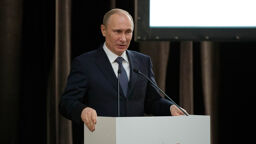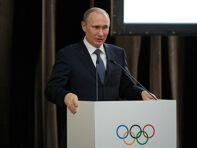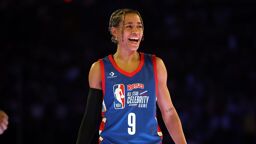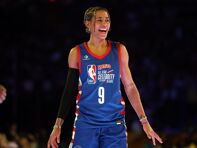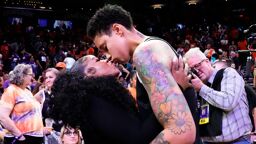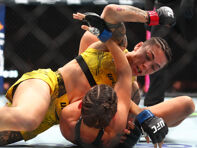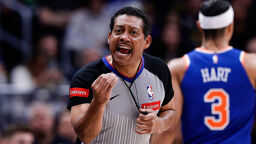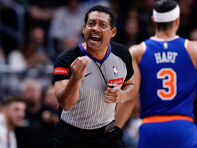Record-shattering tennis legend and out lesbian Billie Jean King tweeted a plea for an end to “conjecture” and to let science figure out the debate over transgender inclusion in sports, recently re-ignited by her friend and fellow icon, Martina Navratilova.
In her tweet Wednesday afternoon, King set a conciliatory tone clearly aimed at trying to douse the flames that Navratilova’s controversial Sunday Times of London op-ed had fanned. She didn’t take sides, but she did make a plea for science, not emotions or bias, to settle the matter.

From the words she chose, it appears she’s reluctant to take sides, although some were quick to see her tweet as an endorsement of their cause. A man whose profile said he was a professional tennis umpire tweeted, “We need more people onboard with us to support our cause 🙏”
King’s tweet started with a defense of her friend, calling Navratilova a long-time “LGBTQ champion” who “cares deeply for the transgender community.”
Then, she wrote the word “however,” which, if it were the word “but” could lead one to think she’s about to say something contradicting Navratilova’s affection for trans people. That’s not where she went as her tweet continued:
“However, instead of conjecture, let’s listen to the science behind transgender women competing fairly in women’s sports. Science is the true arbiter.”
Now the question remains: whose science is to be believed?
The Great Trans Athlete Debate
On the side of transgender inclusion stands Brynn Tannehill, an advocate, author, statistician and former Navy pilot who just happens to be trans.
She wrote in 2014 that the overwhelming consensus in the scientific and medical community is that after one or two years of hormone replacement therapy (HRT), transgender athletes should be allowed to compete according to their gender identity. In another article, Tannehill reported that according to a 2015 study of transgender runners by Dr. Joanna Harper, Chief Medical Physicist at the Providence Portland Medical Center, transitioned trans women performed at the same level they did when they lived as men. At last report, Dr. Harper’s studies are ongoing.
Then there’s the other side, like Otago University professor in physiology Alison Heather in New Zealand, who co-authored a report in April 2018 arguing against trans inclusion.
“Elite trans-women athletes who take hormone therapy and/or have gender reassignment surgery to lower their testosterone to IOC-acceptable levels are likely to retain some of the male physiological advantages prior to transitioning, such as skeletal structure, and heart and lung size.” Heather and her co-authors stopped short of arguing for a ban on trans athletes, and instead proposed the creation of new categories of competition based on social parameters including gender identity, and physiological parameters including testosterone.
Caught in between is a study in the British Journal of Sports Medicine, which concluded in 2005 that trans athletes should be allowed to compete on a sport by sport basis but conceded DNA testing was of “limited practical utility” given the preponderance of varieties of chromosomes. And because of the relatively small number of trans athletes, “the frequency with which transsexual athletes might be expected to have a significant impact on a given sport should be similarly low. “ A 2008 study bemoaned the lack of data on transitioned athletes, concluding: “we may never truly know whether transitioned athletes compete at an advantage or disadvantage.” Eight years later, a similar conclusion, but one that may be interpreted as a victory for trans athletes: “there is no direct or consistent research suggesting transgender female individuals (or male individuals) have an athletic advantage at any stage of their transition.”
So many arguments, so little consensus. Where should Billie Jean direct her friend Martina?
We say, try down under, where we found this little gem of an article debunking myths about trans athletes, and we’ve added some new points as well:
Myth #1: trans women athletes always beat women who have lived as female since birth.
WRONG: In 2018, trans weightlifter Laurel Hubbard of New Zealand was beaten twice at the World Weightlifting Championships in Anaheim. American Sarah Roble won gold, and Roble is cis. The World Health Organization has found there is a range of chromosome combinations beyond just “male” and “female.”
After this article was first published, I asked Tannehill for further thoughts, and she said the most crucial point is this:
“We’ve already answered the question [raised earlier by JC Reeser in the British Journal of Sports Medicine in 2005] of whether letting transgender women compete would ruin the competitive spirit of sports with what amounts to a real live test with objective results and a sample size of thousands.
“Transgender people have been allowed to compete in eight Olympic games since 2004. There has not been a single out transgender competitor, much less medal winner. Even if transgender people participated at the same rate as the general population, you would have expected at least a few. But the number is zero.
“This provides hard, mathematical evidence that not only do transgender people not have any significant advantage, the actual test data could be used to make a case that perhaps they are at a disadvantage overall.. But certainly, you cannot show that when the rubber meets the road in actual large scale competition, that transgender women have some competitive advantage.
“If they did, they’d be over-represented. Instead, the exact opposite is true. In operations research, the Olympic results would be considered better evidence that letting transgender women compete won’t affect the competitiveness of sports than anything conducted in a lab.
“Think of it this way: it’s like laboratory trials vs. clinical trials of a new drug. No matter what the lab tests say, you always end up going with what happens when they try a drug on a real human being under real conditions.”
Myth #2: Testosterone gives trans women a lifelong advantage of strength and speed, even after transition and/or surgery.
WRONG: Men aren’t the only ones with testosterone: women have it, too. And while trans women see their T levels plummet on the HRT treatment of estradiol and spironolactone, cis women continue to produce via their endocrine glands. In fact, as Tannehill noted, 25 percent of the testosterone circulating in the body of a woman with ovaries comes from those egg-producing organs, often giving them more T than the trans woman on HRT changing in the same locker room or peeing next to them in the ladies room stalls. And once that trans woman has surgery to remove her testes, her body produces almost no testosterone at all. Remember that study from 2015 that Dr. Harper was conducting in Portland? A trans woman who has transitioned and spent at least a year on HRT who was in the 75th percentile when she lived as a man will be ranked in the 75th percentile as a woman.
Myth #3: Trans women will always be bigger and therefore stronger than the women they compete against
WRONG: Women, like men, come in all shapes and sizes. But our society and culture dictates that women must look a certain way, typically shorter and more feminine than men, and that men must be taller and stronger than women and more “macho,” to be accepted, attractive, or favored. Cis hetero-nomative privilege at work! Have these people ever even been to a Pride March?
Given that Usain Bolt can outrun his rivals on those amazing feet, and Michael Phelps has won gold after gold with that incredible arm span, why should a bigger, taller woman who happens to be trans be eliminated from competing against other woman?
Myth #4: There is no place for trans athletes in sports
WRONG: Once upon a time, only men could compete. Then women were given the opportunity to play sports, although the divisions according to gender lines remain: ladies tees, different start times for women marathoners vs. men, baseball for men and softball for women, the WNBA vs. the NBA, etc. Nobody should be banned from playing a sport based on how they look, or from doing anything. That said, those gender lines are traditionally maintained so that women have opportunities that they might otherwise lose to male competitors.
The difference then, is whether trans women are permitted to compete as women.
The NCAA has a policy permitting inclusion of trans athletes as does the International Olympic Committee and U.S. Track and Field. The IAAF and World Anti-Doping Agency has their own guidelines, too. In fact, the IAAF is now in a hearing before the Court for the Arbitration for Sport in Switzerland, in the case of Caster Semenya, who wants to race competitively without having to take testosterone suppressants.
Some truth lies beyond these myths, beyond junk science and transphobic policies — like the 2014 guidelines of the Virginia High School League, which mandated trans students must compete in sports according to “the gender of their birth“ and cannot compete according to their gender identity unless they have had gender reassignment surgery — an impossible feat for any high school teenager.
We can only hope Billie Jean King and Martina’s other friends in the trans ally community will someday find that truth, and help her and those who oppose trans inclusion accept it.
EDITOR’S NOTE: This article was updated to include new comments from Brynn Tannehill after it was first published. Those comments were added in the section marked Myth #1.













